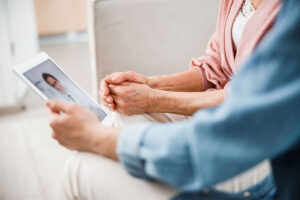 The COVID-19 pandemic has sparked a rapid shift to telemedicine across health care. Among the many challenges this new reality has created for geriatricians is how to adapt the comprehensive geriatric assessment (CGA) to a virtual delivery format.
The COVID-19 pandemic has sparked a rapid shift to telemedicine across health care. Among the many challenges this new reality has created for geriatricians is how to adapt the comprehensive geriatric assessment (CGA) to a virtual delivery format.
In a recent letter to the editor published in Age and Ageing, clinicians from the Brigham and Women’s Hospital Division of Aging summarized their experience in administering the CGA via telephone and video visits. The authors struck an optimistic tone.
“Prior to the pandemic, there wasn’t much information about whether it was feasible or valid to perform the CGA via telehealth,” said lead and corresponding author Julia V. Loewenthal, MD. “We’ve found that the CGA can be adapted very well for telehealth delivery; it just requires some creativity.”
It also requires patience. “You have to change your thinking a little bit,” she cautioned. “You probably can’t do the entire CGA in one visit with telehealth. There are certain portions, such as hearing, that may need to wait until the next in-person visit. But at this point, we feel like it’s been a pretty seamless transition.”
Benefits of Virtual Care Delivery for Geriatric Patients
Early in the pandemic, the Brigham’s Division of Aging delivered all inpatient and outpatient services virtually. After four weeks, according to the letter, “inpatient services transitioned to a hybrid model while outpatient remained mostly virtual.” About three-quarters of the virtual visits took place over the telephone, with the remainder via video.
In a survey of division clinicians, 71 percent “reported that patients found telehealth acceptable all of the time, with 29% most of the time.” Dr. Loewenthal said that despite initial concerns, clinicians came to view telehealth favorably as well.
“It requires a huge change in your daily routine and how your clinic is run, but it also cuts down on commuting time because you can work from home part of the week,” she explained. “Also, rooming patients in a geriatric clinic often takes a lot of time because they walk slowly or struggle to get up and down from chairs or the exam table. Telehealth has eased some of those time pressures.”
Dr. Loewenthal added that video visits provide a valuable glimpse into patients’ daily lives — the medications they are taking, the food and supplies at their disposal and more.
“Initially, we were bemoaning the fact that we couldn’t see patients in person to do physical exams or observe their gait,” she said. “But we eventually found that seeing them in their houses made a big difference in terms of the care we could provide. And in many cases, the resulting assessments — as with medications, for example — were a lot more accurate.”
Working Around Telehealth Shortcomings
The clinicians from the Division of Aging acknowledged important shortcomings of telehealth. For instance, some patients — particularly those with cognitive impairment — are unable to use the technology for video visits. In those cases, Dr. Loewenthal noted, she and her colleagues ask a family member or home health aide to facilitate the interaction.
Assessing patients for hearing impairment (e.g., via a finger rub or whisper test) can also be difficult, if not impossible, in a virtual environment. One solution, purchasing an over-the-counter amplification device, makes sense for some patients but is cost-prohibitive for others.
“Especially for patients with dementia, hearing loss or other issues that are hard to get at over the phone or video, we’ve tried to do a hybrid model,” Dr. Loewenthal said. “We’ll see them for every second or third visit in the office, and in between we’ll have virtual visits.”
With COVID-19 vaccinations underway, Dr. Loewenthal is optimistic that patients who have avoided the clinic due to fears of contracting the virus will soon be returning. She is similarly optimistic about the future of telehealth in geriatrics.
“Telehealth allows more flexibility for both patients and their clinicians,” she said. “We are hoping it will continue to play a role, with appropriate adaptations, even after the pandemic.”